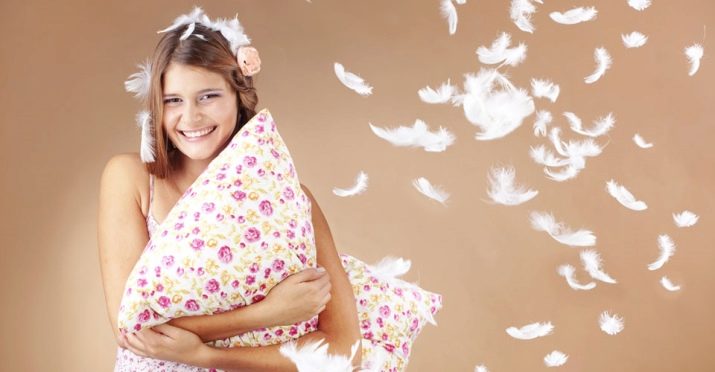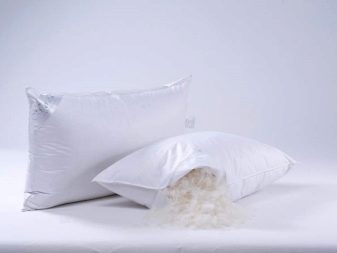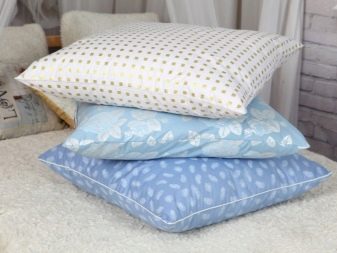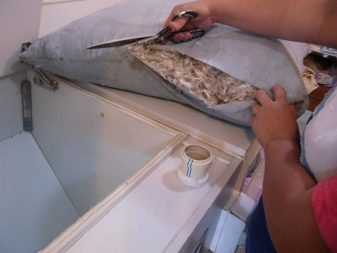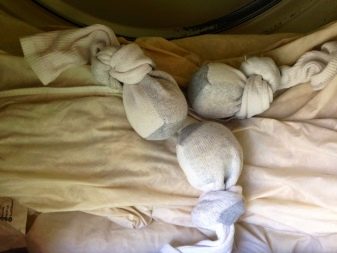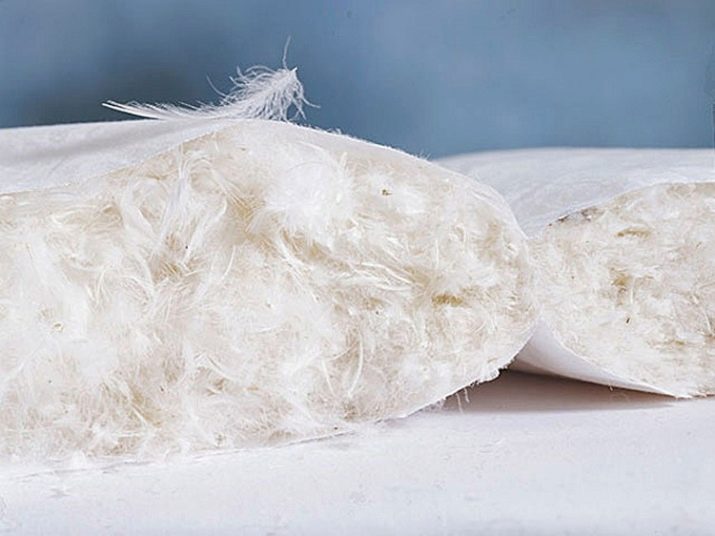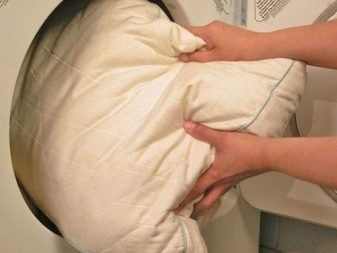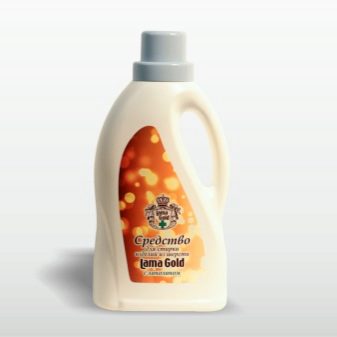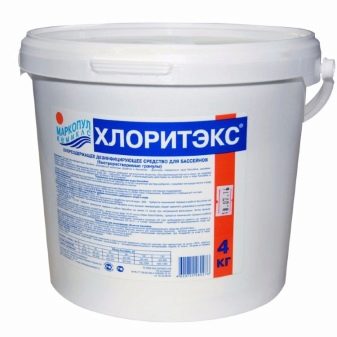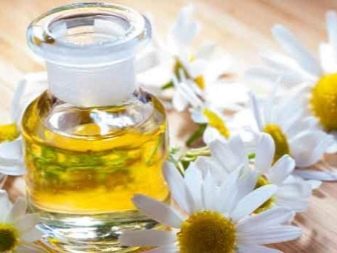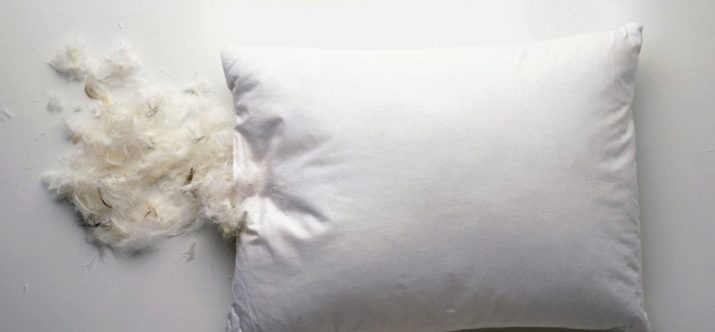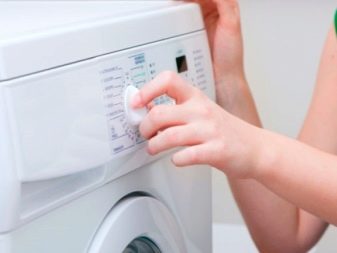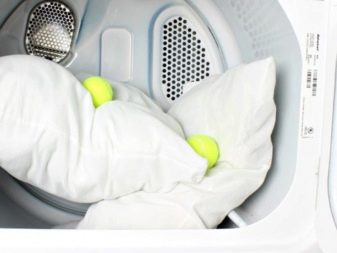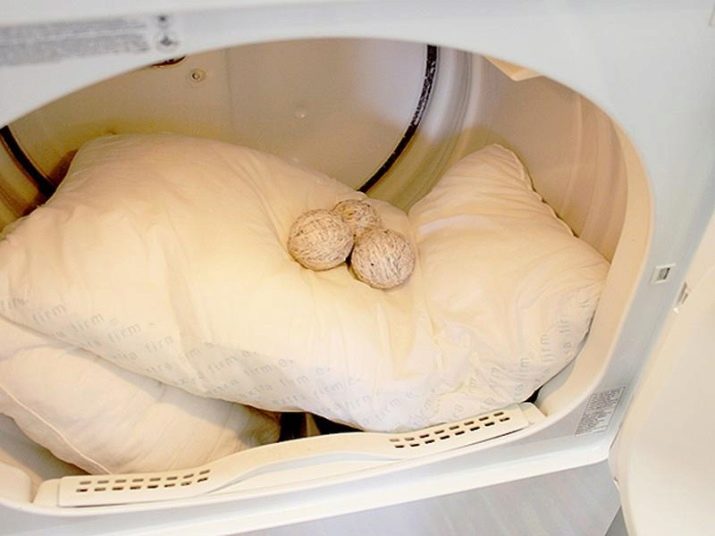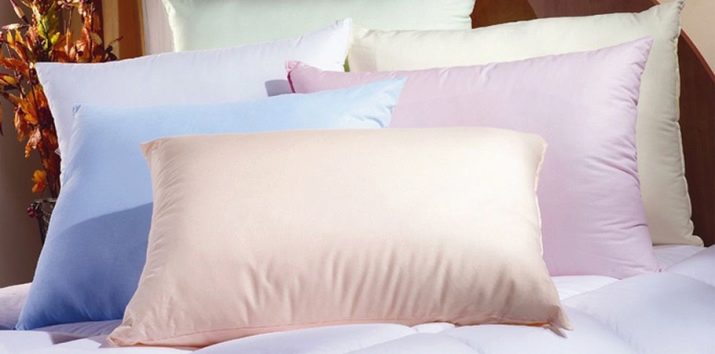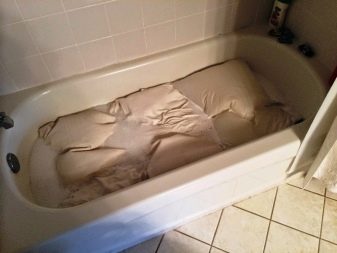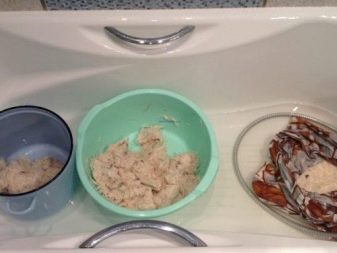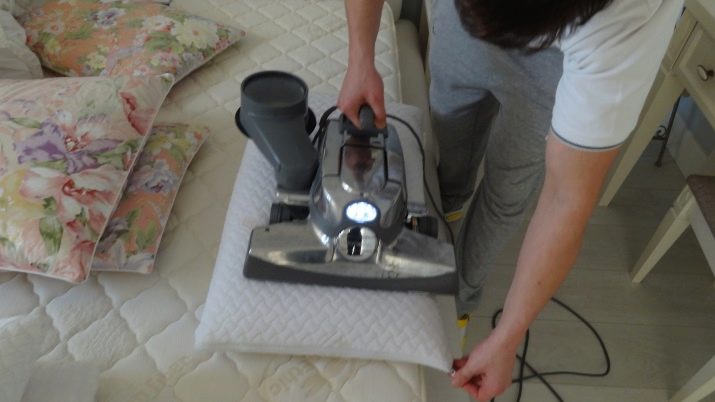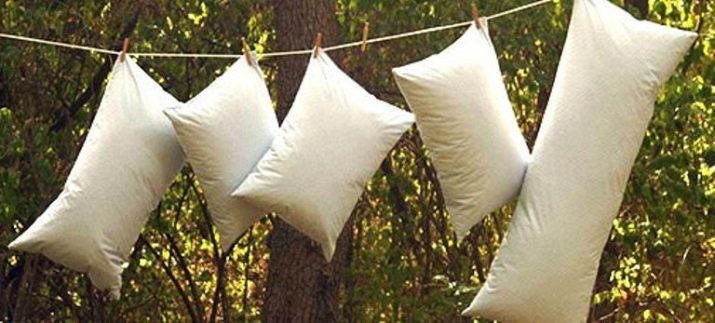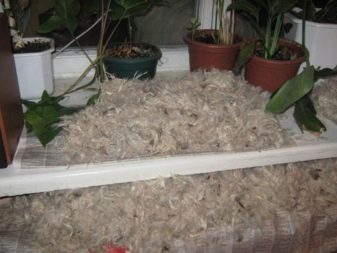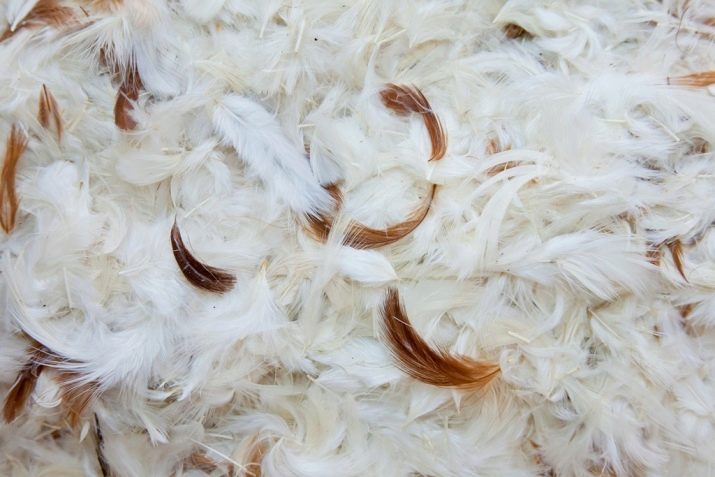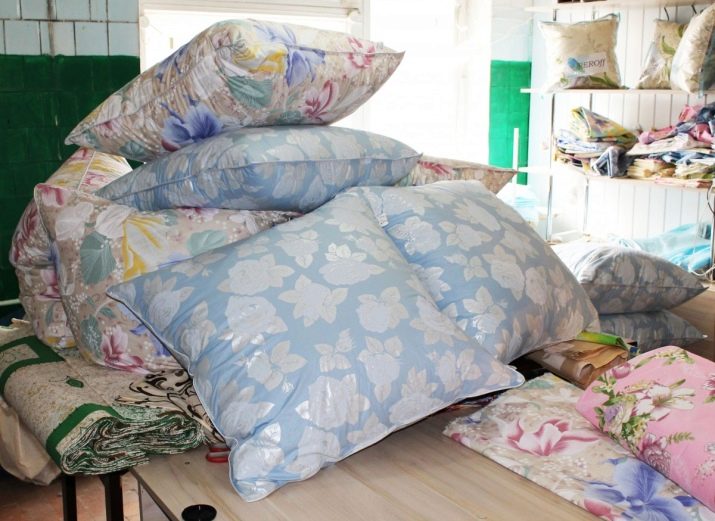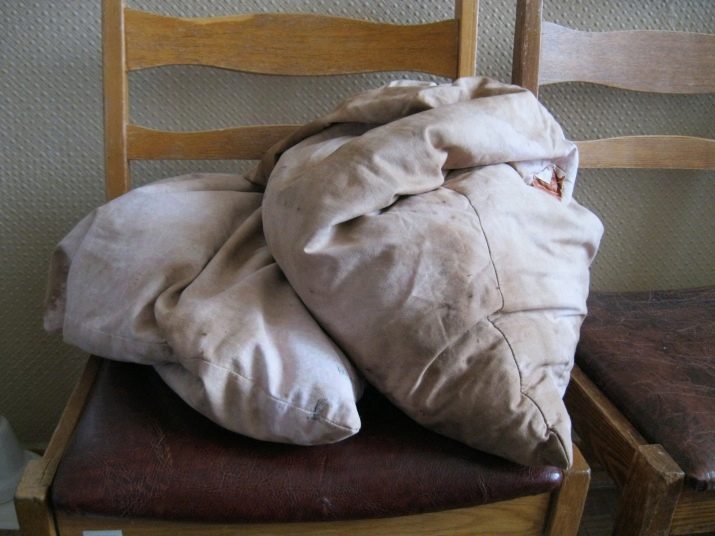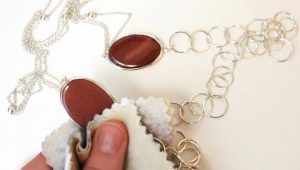How to wash feather pillow at home?

The modern market offers a huge selection of pillows with various fillings: vegetable buckwheat husks, natural camel wool, bamboo, synthetic holofiber. Each person has different requirements for a pillow for sleeping in order to feel rested in the morning. Fashionable environmental trends have led to the fact that downy products are again in demand. And many simply follow the old fashioned loyalty to the beloved “homemade” feather pillows. Consider the characteristic features of a household item with natural classic padding.
Features
Fill pillows with down and feathers of waterfowl: geese, ducks, swans, less often chicken feathers. This natural cushion is hygroscopic, silent, durable, has good breathability, has excellent thermoregulation, keeps its shape well. She is considered the most comfortable. The feather filler has no smell.
However, poultry fluff is contraindicated for people with allergies.
Natural material quickly absorbs moisture and accumulates dust, collects dead skin and hair cells, secretions of the sebaceous and salivary glands, thus becoming a favorable atmosphere for the reproduction of mold, germs and ticks. Why there are problems with the respiratory system, skin.
It does not even occur to many housewives that the danger to health is represented by a dirty feather inside a napernik. Caring for the bed is limited to changing pillowcases, sheets and duvet cover. This is not enough.
To prevent the occurrence of diseases, it is necessary to regularly clean the feather pillows. Frequency of general processing of downy items - 1-2 times a year. More frequent cleaning damages feathers and reduces product life.
The procedure for processing pillows at home is very complicated, but possible. Wash the finished pillow is not recommended. You will not achieve the desired effect, just get rid of a small amount of dust. In addition, you will encounter difficulties in completely drying the product. In order for the washing process to take place qualitatively, it is necessary to prepare for it initially.
Training
Determine which bird feathers your pillow is filled with. If it is chicken feathers, then the product can be safely disposed of. Or, take the pillow to a specialized workshop and order a dry cleaning, warning that the pillow is stuffed with feathers of chickens. Chicken feathering is strictly prohibited to erase. The down of this bird does not tolerate moisture, it dries very poorly, and in the process of hygienic processing it can simply turn into dust.
It is possible to erase feather fillers of waterfowl only. Sew a few covers for washing feathers. At least one standard size pillow will require at least 5 bags. For sewing, you can use any thin cotton fabric, chintz, teak. Old pillowcases, tulle or pillow-case will do.
It is better not to use gauze, as it will not hold down. Or fold it in three or four layers before sewing the covers.
Determine the size of the bags. We measure the pillow, which are going to wash. We increase the length by 2 times, and the width remains the same. On the calculated parameters we sew additional bags.
If you do not want to sew a lot of extra pillowcases, then sew one, 3 times more pillows. Some hostesses resort to another method: they sew small bags of 20x20 cm in size and fill them with 100,000 fluff.
Before washing:
- Knock feather pillow from dust.
- We unpack one edge of a napernik on a seam.
- Carefully move the down filler into the prefabricated covers.
- Firmly sew up the open edge of the bags.
Shift the feather filler on a damp cloth, the down will linger on its surface and will not scatter on the floor.
You can clean the pillow only by following our recommendations.
Facilities
For washing down-feather bedding products use certain means that do not damage the base of the pillow. It is better to use liquid detergent powder, gel for wool products, shampoo. They gently act on the down during the wash.
Remarkably suitable funds, which include lanolin. It prevents rapid contamination of the fibers of the feathers, making them supple and soft. Many hostesses prefer a folk remedy, time-tested. They rub a grated baby or laundry soap and dissolve it in water. Chlorine-containing concentrated bleach is also used in washing, it eliminates and prevents the appearance of dust mites.
Remember that ordinary dry powder is not suitable for the care of down pillows. Its large particles are poorly washed out of feathers. Also not recommended universal powder, its bleaching ingredients and enzymes have a damaging effect on the structure of fibers.
Do not use a strong perfume when rinsing. Downy filler absorbs odors, and an obsessive scent causes a headache. It is better to use a couple of drops of any essential oil instead of perfume in the secondary rinse. For example, basil scent eliminates insomnia, marigolds are good sleeping pills and restore emotional balance, the wonderful scent of jasmine enhances sensuality and creates an intimate atmosphere, and medicinal chamomile oil has a huge range of healing qualities, it soothes and strengthens.
Essential oils will give the product a light, unobtrusive fragrance and will help to remove dust mites from fluff.
How to care?
Washing feather pillows at home is a rather difficult and long process. Wet cleaning can be done in different ways: manually or using a washing machine.
In the washing machine
Most women prefer not to spend time and effort on washing hands, and use the machine-gun. Wash the whole feather pillow impossible. The filler will be confused in one com. In addition, the dry pillow has a weight of about 5 kilograms. Having absorbed the water, it will turn into a “training” weight, which not every washing machine can master. Washing down pillows of swan down in a washing machine is possible if certain conditions are met:
- choose a delicate mode or hand wash mode;
- if the machine has a “fluff” or “duvet” mode, then set it up;
- we type the temperature not higher than 40 degrees, preferably 30;
- set the mode with a minimum number of revolutions;
- we place special soft plastic balls or tennis balls in the drum; when they are washed, they will prevent the feathers from sticking into one lump and remove all contaminants;
- distribute the load on the drum. It is advisable, in addition to the cover with feathers, put a few towels. This will allow the washing machine to work properly and eliminate its strong vibration;
- rinse covers with feathers need at least two times. Do not forget to add a flavoring agent before the last cycle.
If the washing machine has an automatic drying function, the process is simplified several times, runs better and faster. Select the desired mode and exit.
Important: when washing in the machine can not use spin mode. When spinning, feathers break and become debris. It is possible to press covers with down filling only manually.But if you still ventured to use machine spin, then choose the mode with the least number of turns (up to 400).
Manual mode
Manual processing is a longer and tedious procedure than washing in a washing machine. This method of cleaning can be carried out both in bags and without bags:
- Fill a large container with water at a temperature no higher than 40 and no lower than 30 degrees. Do not use hot water. From her protein, which is contained within the feather, is folded, and the down gets an unpleasant smell, you can not get rid of that later.
- Add liquid powder or other detergent and mix. The following solution cleans feathers well: for 5 liters of water, 150 grams of rubbed soap and 1 teaspoon of liquid ammonia.
- Put a bag of filler in the container or add a piece of feathers. The down should float freely on the water, and not lie on its surface in a thick layer.
- Soak in warm soapy water for 2-3 hours.
- Put the feathers in a colander and rinse under the tap. If you wash in the covers, then wash the bags, change the used water to another soap solution and repeat the procedure until the water remains clean.
- Change the water and continue cleaning in the same sequence with the remaining covers or fluff.
- After washing, thoroughly rinse the feathers in clean water. You can rinse in water with air conditioning or with 2-3 drops of essential oil.
- Carefully squeeze out the washed feathers.
- Immediately after washing, gut the crumpled feathers. Spread them evenly on an absorbent cloth. Suitable and a large towel or sheet, baby diaper. Roll the cloth with a wet feather into a tight roll. The fabric will take on the main moisture.
- Do not forget to wash an empty pillow or replace it with a new one.
Steam cleaning
Not all housewives know that one of the ways to clean feather pillows at home is steam cleaning. It doesn't matter if you have a steamer or steam cleaner. You can also resort to the steam method using a conventional iron with a function of vaporization or vertical steaming:
- Secure the pillow upright. For example, you can hang it on a rope.
- Process the surface of the pillow on both sides with steam.
- After 10-15 minutes, repeat the cleaning process and leave to dry. You can hang a pillow in the sun.
- After drying, straighten the filler with your hands.
Of course, steam cleaning is not a full wash, but it will protect and update the pillow. Microorganisms and bacteria, dust mites are dying from the effects of hot air from steam generators. Bed product gets rid of unpleasant smell. With the help of steaming, the feather filler is cleared of dust, the pillow acquires freshness.
Drying
In addition to washing, an important step in cleaning a classic pillow is proper and proper drying. If you approach this process irresponsibly, the filler will stick together in lumps, will become moldy, and acquire a fetid odor. Wet feathers will lead to the growth of fungi and harmful bacteria in them. At home, you can use the following pillow drying options:
- Drying in the open air. A good option for the summer. After a soft, delicate manual spin, place the feathers in bags made of fine fabric. Mash the lumps with your hands, shake the covers with feathers. Hang the bags outdoors so that the wind blows them. You need to hang in the shade, because the sun's rays negatively affect the elasticity and structure of the fluff. So that the feathers do not damp inside the cover, they should be periodically shaken and kneaded. In hot, windy weather, the fluff dries out in a fairly short time. In addition, ultraviolet rays promote disinfection.
- Drying on the battery. In the old days, women washed their underwear in the winter, giving it a good chance to freeze out and acquire unique frosty freshness. Frost kills germs, but does not dry down.Therefore, the best option for drying feather pillows for winter time - drying on the battery. The method is very simple - lay bags of fluff on the radiator.
Beat and turn over the filler constantly, as the feathers shrink on the battery too quickly.
- Drying in the room. The most convenient and common option is drying in the room. Spread the pen filler on any horizontal surface in a ventilated area. It is desirable to pour it on paper or several times folded moisture-absorbing fabric. As a last resort, use a newspaper, but light feathers are most likely to get dirty with ink. Wet down stir as often as possible to ensure the flow of fresh air. To prevent the drying process from happening, place a small amount of fluff on the selected surface.
If you expand the filler between two layers of gauze, you can speed up the drying with a hair dryer. Remember that feather filler must be dried in 2-3 days. If the drying process was unsuccessful, and the down got an unpleasant smell, you need to restrain the feathers again, repeating the whole procedure again.
After drying, cover the floor with a dry sheet or oilcloth, then you will save yourself from the hassle of cleaning the room. Transfer the feathers to a clean or new bedtick. You can add a handful of hops together with feathers in the bedtick. The smell of hop cones has a calming effect on the nervous system and helps eliminate insomnia. Sew a bedtick seam tight.
Useful tips and tricks:
- The best time for such hard work with pillows is summer. On a warm fresh air stream, the filler dries faster, in the winter time drying will be delayed or it may not work.
- Before washing, you can spend prevention pillows from bed mites. Take 10 liters of water, add 1 teaspoon of boric acid, 500 grams of soap and 100 grams of ammonia. In the resulting liquid soak the pen for 1 hour.
- Pooh clogs the sewage system, therefore erasing in the bathroom, we advise you to close the opening for draining the water with a protective net.
- Before washing the bags with feathers in the washing machine, once again check the reliability of the used covers, if there are any holes in them. Bags must be tight. Loose fluff can clog the filter of the machine, and it will fail.
- If the pillow is old, add liquid ammonia (a spoonful of 5 liters of water) or vinegar to the water when washing, they will remove the old smell.
- To make the new pillow-less dirty, before you fill it with feathers, walk inside with dry soap.
- Under the main pillowcase is better to wear another extra thin fabric. This will prevent napernik and fluff from rapid contamination.
Pathogens contained in the sputum and saliva of a sick person, are absorbed into hygroscopic fluff and cause re-infection or lead to a relapse of the disease. Therefore, a pillow for those who are ill during recovery should be treated with steam.
- Once a month, vacuum the pillows with a regular vacuum cleaner and put them in the sun.
- No wonder our grandmothers daily whipped down pillows. During shaking, air chambers are formed between the lint of the down, so the down product is saturated with air and provides good thermal insulation.
- After taking a bath or shower, dry your hair before lying on the pillow. Moisture quickly destroys fluff.
- It is recommended to store bed products in special covers for the storage of down pillows and blankets. Do not store pillows in airtight bags and plastic containers.
The shelf life of feather bedding products is no more than 5 years. After this time has elapsed, the feather becomes the dust and habitat of harmful bacteria, and the pillow loses its original softness. Of course, it is difficult to part with your favorite pillow. But you must admit, it is not as comfortable as before. In addition, after the expiration of the service life, the number of microbes in it increases, and the “native” pillow becomes dangerous to health.
The process of cleaning pillows at home is very long, time consuming and difficult. It is suitable for people who like to control the general cleaning and trust only the care of cleaning. If you are mentally prepared, gain strength and perform such difficult work, you can be congratulated. Now your bedding is clean, fragrant, soft and airy.
How to wash feather pillow at home, see the following video.
